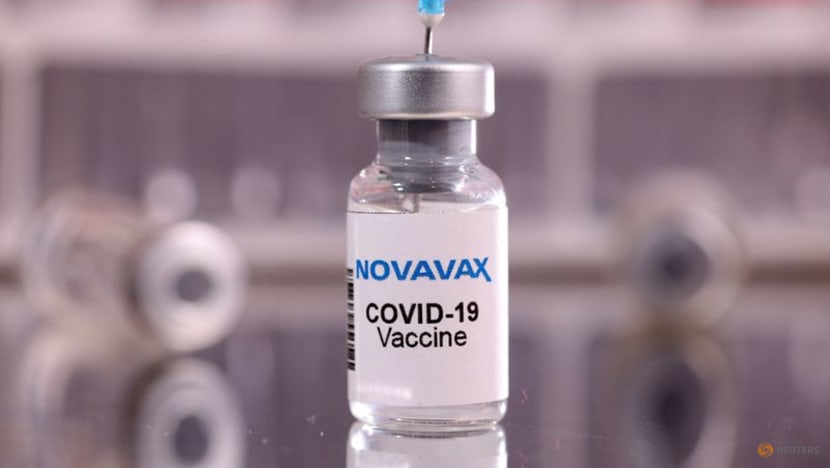'Misperception' to associate stroke, heart attack with COVID-19 vaccination: Ong Ye Kung
"Even before COVID-19 and vaccination, every day, there are 60 Singaporeans who either suffer a heart attack or stroke," says Health Minister Ong Ye Kung.

A vial labelled "Novavax V COVID-19 Vaccine" is seen in this illustration taken on Jan 16, 2022. (File Photo: Reuters/Dado Ruvic)

This audio is generated by an AI tool.
SINGAPORE: The association of COVID-19 vaccination with severe side effects like stroke, cancer and heart attack is a "misperception" that has to be corrected, said Health Minister Ong Ye Kung on Saturday (Nov 25).
Speaking at the official opening of Sembawang Polyclinic at 21 Canberra Link, Mr Ong said the Ministry of Health has been "very transparent" about the side effects and risks of all vaccinations.
He acknowledged that when talking to residents about taking the COVID-19 vaccination at least once a year, the common reaction was to worry about side effects but the side effects were generally "a bit of ache in the arm or slight fever".
"But today, if residents are worried about severe side effects like stroke, cancer and heart attack and they associate this with vaccination, we have to correct this misperception," he added.
"In the case of COVID-19 vaccination, the risk of myocarditis, especially amongst younger males, is well established and we have been publishing the results.
"But even before COVID-19 and vaccination, every day, there are 60 Singaporeans who either suffer a heart attack or stroke, and six more Singaporeans require kidney dialysis."
Mr Ong said these cases "are driven by lifestyles over many years" via the accumulation of too much salt and sugar, lack of exercise and smoking.
"But when you have so many people suffering from stroke, heart attack and dialysis every day, after a while, they start associating and blaming it on vaccination."
"We cannot link the two," Mr Ong said, adding that if one is really worried about heart attack, cancer and stroke, they should adopt healthier lifestyles.
In May, Mr Ong responded to questions from Member of Parliament Tan Wu Meng (PAP-Jurong) about myocarditis or heart inflammation after COVID-19 vaccination, then saying there were 160 reports of myocarditis and pericarditis linked to the vaccines as of Apr 27.
This was out of over 17 million COVID-19 vaccine doses administered in Singapore.
Of the 160 cases, he said 32 per cent had initial symptoms reported within one day of vaccination, another 20 per cent reported within two days and another 24 per cent reported within one week.
"The majority of cases of myocarditis from vaccination are generally mild and respond to treatment," said Mr Ong to the House in May.
SURGING RESPIRATORY ILLNESSES IN CHINA
Cases of respiratory illnesses have been surging in northern China, particularly among children, sparking speculation online of a new pandemic threat four years after COVID-19 first emerged in the country.
However Chinese health authorities have said the rising infections are a mix of already known viruses and are linked to the country's first full cold season after strict COVID-19 restrictions were lifted last December.
On the recent reports of an infection surge in China, Mr Ong said on Saturday this is "not unexpected" as a "winter surge" tends to happen in temperate climates.
"Mostly kids are affected, with known infections such as RSV, influenza and adenovirus. The spread is higher with more social interactions happening indoors during winter," he added.
Mr Ong said Singapore went through a similar phase when COVID-19 measures were first relaxed and "there was a bit of a rebound in infections once we opened up".
"But this is also a useful juncture to remind ourselves that if we stop vaccinating, something similar may happen here when protection from previous vaccination wanes. Therefore it is important for us to keep up with our vaccination."
BUKIT CANBERRA DEVELOPMENT TIMELINE
With the opening of Sembawang Polyclinic, Mr Ong said that Bukit Canberra Phase 2 was almost completed.
On the remaining Phase 2 projects, he said the aim was to complete the childcare centre, eldercare centre, the bridge going across the road and the therapeutic garden by the middle of next year.
Phase 1 saw the opening of the multipurpose hall and the hawker centre, while the swimming pool and gym were opened earlier in Phase 2.
"Residents can then look forward to Phase 3, which is quite special, with the refurbishment of Admiralty House into a library," Mr Ong said.
"Next to the library will be another swimming pool, which is a special one built after World War II, which we are preserving and enlarging. With that, it will signal the final completion of Bukit Canberra development."
















